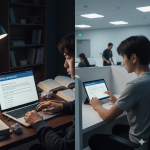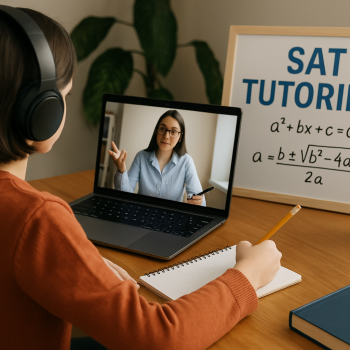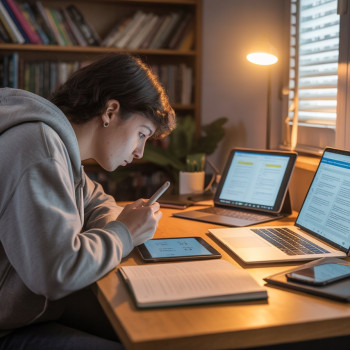Introduction: You’re Not Alone — Navigating the Digital SAT with a Disability
Applying to college is a big step for every student. For students with disabilities, that step often comes with extra questions: How will accommodations work on a digital test? When do I apply? What documentation is needed? Which parts of the process require action from me, my parents, or my school? This article answers those questions with empathy, clarity, and practical steps so you and your family can feel confident and prepared.

Why the Digital SAT Changed the Conversation About Accommodations
The SAT moved to a digital format to modernize the experience, speed up scoring, and make the test more flexible. For many students with disabilities, that change brings both advantages and new considerations. Technology can make certain accommodations—like text enlargement, built-in calculators, or text-to-speech—more seamless. But it also requires careful planning: some accommodations that were human-delivered on paper tests work differently online.
Understanding how accommodations translate in a digital environment is the first step. With the right preparation, students can take full advantage of the tools available to them while avoiding surprises on test day.
Basic Steps: From Documentation to Test Day
Think of the accommodations process as a series of intentional steps. The earlier you start, the more options you’ll have. Below is a straightforward roadmap you can follow.
1. Talk to Your School’s SSD Coordinator or Counselor
Your school’s Services for Students with Disabilities (SSD) coordinator or counselor is the primary partner in this process. They know how to submit requests, what documentation the College Board typically looks for, and how to coordinate with teachers and medical professionals. Start here—this conversation often triggers the official paperwork.
2. Gather Documentation
Documentation should explain the functional impact of the disability and how it affects testing. It’s about current need, not labels. Depending on the situation, this could include:
- Recent evaluations from qualified professionals (psychologists, physicians, speech-language pathologists, etc.).
- IEP or 504 plans that show the accommodations used in school.
- Teacher observations or classroom performance notes when appropriate.
Tip: Ask your SSD coordinator what the College Board requires for each specific accommodation. Updating documentation a year or two before the SAT often saves stress later.
3. Submit the Request via SSD Online
Requests for College Board accommodations are submitted through SSD Online, typically by the school’s coordinator. It’s not a student-run portal; the SSD coordinator plays a central role. Once submitted, allow enough processing time—approval can take several weeks, and in some cases longer. Starting early is key.
4. Know the Timeline
Plan ahead: accommodation requests are best submitted at least seven weeks before your intended test date. If your request is approved, confirm your accommodations when you register so they appear on your admission ticket. If they do not appear, contact SSD immediately—you may need to reschedule if changes can’t be processed in time.
5. Practice in the Bluebook Environment
The College Board’s Bluebook app is the testing platform for the digital SAT. Students who will use accommodations should practice in the Bluebook environment—many universal tools (zoom, highlights, line reader, calculator) are available to everyone, and approved accommodations (text-to-speech, extended time) will appear when the student’s profile is loaded. Practicing reduces technical anxiety and builds fluency with the interface.
How Common Accommodations Work on the Digital SAT
Some accommodations translate directly into digital tools, while others get adapted. Below is a practical guide to common accommodations and what to expect.
Extended Time and Breaks
Extended time is one of the most requested accommodations. On the digital SAT, extended time typically appears as additional time baked into the student’s digital test session. The platform also supports extra or extended breaks. Important: the way extended time is presented may differ from in-class testing; students should practice the pacing with their approved time.
Text-to-Speech and Screen Readers
Many students who previously used a human reader will use embedded text-to-speech tools or approved screen reader software with the digital test. For most, this is efficient—but it’s essential to confirm which mode is approved. Occasionally, students with particular needs may still receive approval for a human reader, but that’s considered in special circumstances.
Dictation and Scribes
Students who used a scribe on paper exams often get approved for dictation (speech-to-text) in the digital format. That reduces the need for a human scribe in many cases. If a student cannot use speech-to-text for medical or functional reasons, an accommodation for a human scribe may still be granted.
Magnification, Color Contrast, and Large Print
Digital tests offer zoom, color contrast settings, and other visual tools. For many students who needed large print, the zoom and system-level magnifiers are sufficient. If assistive technology beyond these tools is required, the SSD review will consider alternatives.
Assistive Technology and Devices
Approved assistive technology that a student uses in day-to-day learning often can be used during the digital SAT. It’s critical to confirm that the specific software or device is College Board–approved and properly configured for Bluebook. Practicing with these tools in a test-like setting is recommended.
Checklist: What to Do and When
Use this checklist as your quick reference. Treat it like a timeline you can tailor to your family’s schedule.
- 12+ weeks before test: Discuss plans with SSD coordinator; gather updated documentation.
- 8–12 weeks before test: SSD coordinator submits accommodation request via SSD Online.
- 7 weeks before test: Ensure you’ve requested accommodations at least seven weeks before test date; if late, be prepared to reschedule.
- After approval: Register for the test and confirm accommodations are listed on your admission ticket.
- 4–2 weeks before test: Practice in Bluebook with your approved accommodations if possible.
- Test week: Verify your admission ticket shows accommodations; pack any approved accessories (headphones, prescriptions, glucose monitor, etc.).
Table: Common Accommodations and Digital Equivalents
| Paper Accommodation | Typical Digital Equivalent | What to Practice |
|---|---|---|
| Human reader | Embedded text-to-speech or approved screen reader; human reader in rare cases | Listening pace, navigation while listening, marking passages |
| Large print | Zoom/magnification in device or Bluebook | Font size, line spacing, scrolling behavior |
| Scribe | Dictation (speech-to-text) or human scribe as needed | Speech-to-text accuracy, voice commands, edit flow |
| Extended time | Extended digital test time (e.g., time-and-a-half) | Timing strategies, pacing over longer sections |
| Color overlay | Color contrast/filter settings | Contrast settings, readability in different lighting |
Practice Strategies That Really Work
Practice for the digital SAT is not just about content—it’s about comfort with the interface, tools, and pacing of your approved format. Here are concrete strategies that produce results.
1. Simulate Real Conditions
When you practice, recreate test conditions as much as possible: same device, same internet conditions (if applicable), same allotted time, and the same assistive tools. If you’ll use text-to-speech, do full passages with it on so you understand how listening affects your reading speed and comprehension.
2. Use Tool-Specific Drills
Spend practice time with the exact tools you’ll use on test day. If you’ll rely on zoom and line reader, make timed drills that force you to use those features. If dictation is your tool, practice speaking answers and editing them quickly.
3. Prioritize High-Leverage Content
Not all SAT content is equally valuable. For many students, improving on the most common question types—command of evidence, heart of passage, algebraic problem solving—yields the fastest score gains. Pair content practice with accommodation practice: for example, practice reading comprehension with text-to-speech and then answer evidence-based questions.
4. Build Endurance
Extended time means you’ll be at the desk longer. Build stamina with longer practice sessions that gradually mirror your approved testing duration. Practice healthy test rituals: short breaks, hydration, and brief physical movement between blocks.
How to Prepare Documentation That Speaks to Need
College Board reviews documentation to determine functional need and the most appropriate accommodation. Documentation should clearly connect the diagnosis to day-to-day academic impact and testing needs. Useful elements include:
- A clear summary of the diagnosis and date of evaluation.
- Current test scores or classroom evidence showing how the disability affects timed academic tasks.
- Examples of accommodations used effectively in school (IEP, 504) and why similar tools are needed for standardized testing.
Work with your SSD coordinator and diagnosing professional to make documentation concise, specific, and current.
What Families Can Do to Support Their Student
Parents often carry both logistical and emotional loads. Your support can be practical and gentle—helpful actions include:
- Keeping a shared timeline and calendar for deadlines and practice sessions.
- Attending meetings with your SSD coordinator and advocate when needed.
- Providing a calm, distraction-free space for practice and test day routines.
- Helping the student advocate for themselves—teach them how to check that accommodations are listed on the admission ticket and who to call if something’s missing.
How Personalized Tutoring Can Make a Difference
Many families find that targeted, personalized help accelerates progress. Personalized tutoring—like Sparkl’s 1-on-1 guidance—can be a game-changer because tutors create tailored study plans, model how to use accommodations during actual SAT problems, and provide consistent practice in the Bluebook environment. Tutors who understand both disability needs and test strategy can help students build confidence and translate their strengths into better scores.
Sparkl’s approach blends expert tutors with AI-driven insights to track progress and adapt lessons to each student’s pace—useful when you want practice to mirror the exact tools and timing a student will have on test day. Because timing and interface familiarity matter so much on the digital SAT, a tutor who practices with those exact conditions can reduce surprises on test morning.
Practical Test-Day Reminders
On test day, small details matter. Here’s a short list of practical reminders to keep the test day calm and efficient:
- Confirm that your admission ticket lists the approved accommodations.
- Bring any prescribed devices, chargers, and approved accessories (e.g., headphones, glucose monitor, weighted blanket if allowed).
- Arrive early to address any unexpected setup or access needs.
- Pack snacks and water for after the test; if you have medical needs during the test, make sure proctors know the plan.
- Have contact numbers—your school SSD office and the College Board’s SSD help line—handy in case immediate issues arise.
Real-World Stories: Small Wins That Matter
Every student’s journey is unique, and small victories add up. One student who used text-to-speech for the first time found that listening made the main ideas in reading passages pop out more clearly; another, who was nervous about keyboard-based math, gained confidence after a few weeks of dictation practice and writing algebraic expressions aloud.
These moments—discovering a new tool, completing a full practice test without anxiety, or learning to ask for help—are as important as score improvements. College admissions officers look for preparation, resilience, and the ability to advocate for oneself just as much as they look at numbers.
Common Questions Families Ask (and Simple Answers)
Q: What if my accommodation request is denied?
A: Read the decision carefully and discuss next steps with your SSD coordinator. You may be able to provide additional documentation or clarify functional impacts. There’s often a process for reconsideration.
Q: Can I take the test on a different device?
A: Students often use school-provided devices for in-school administrations and must use the Bluebook environment. If your assistive technology requires a specific device or configuration, discuss this early with SSD to ensure compatibility and approval.
Q: Does testing with accommodations affect college admissions decisions?
A: No. Colleges receive score reports but not the details of testing accommodations. The goal of accommodations is to level the playing field so your scores reflect your knowledge and skills.
Final Thoughts: Planning, Practice, and Advocacy
Preparing for the digital SAT with a disability is a process, but it’s one you can manage with thoughtful planning, consistent practice, and the right support team. Start early, partner closely with your SSD coordinator, practice in the Bluebook environment, and consider targeted tutoring if you want personalized pacing and expertise—Sparkl’s tailored plans and 1-on-1 tutors can be particularly helpful for students who benefit from practice that mirrors their exact testing conditions.
Above all, remember this: accommodations are about access and fairness. Your needs are legitimate, and the system is designed—when used proactively—to give you the tools to show what you know. Take it step by step, celebrate progress, and reach out for help when you need it.

Resources to Ask Your School About
When you talk to your SSD coordinator, consider asking about:
- How and when the school submits SSD Online requests.
- Whether your school schedules Bluebook practice sessions for accommodated students.
- Which local professionals the school recommends for updated documentation when necessary.
- How the school coordinates in-school testing with College Board timelines.
Wrap-Up: You’ve Got This
Applying to college after taking the digital SAT is an achievable goal for students with disabilities. With clear documentation, an early application for accommodations, focused practice in the Bluebook environment, and supportive adults at home and at school, students can navigate the process with confidence. If extra help would reduce stress and sharpen strategy, personalized tutoring—be it Sparkl’s 1-on-1 guidance or another trusted option—can provide targeted practice and steady encouragement.
Focus on small, consistent steps: document the need, get the SSD request in early, practice with the exact tools you’ll use, and build test stamina. Together, these actions will help your student walk into the test room prepared, calm, and ready to show what they know.
Need a Quick Checklist to Take Away?
- Contact SSD coordinator: today or this week.
- Gather/refresh documentation: within the month.
- Submit SSD Online request: at least seven weeks before test date.
- Practice in Bluebook with accommodations: weekly until test day.
- Confirm accommodations on admission ticket: at least one week before test day.
Good luck—and remember, your path to college is about persistence, support, and showing your true strengths. Take it one step at a time.















No Comments
Leave a comment Cancel